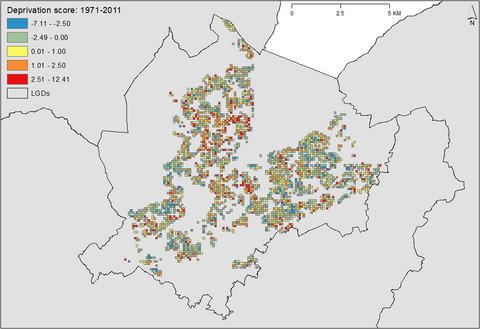Our official English website, www.x-mol.net, welcomes your feedback! (Note: you will need to create a separate account there.)
Neighbourhood change, deprivation, and unemployment in Belfast
The Geographical Journal ( IF 3.384 ) Pub Date : 2021-11-06 , DOI: 10.1111/geoj.12424 Christopher D. Lloyd 1
The Geographical Journal ( IF 3.384 ) Pub Date : 2021-11-06 , DOI: 10.1111/geoj.12424 Christopher D. Lloyd 1
Affiliation

|
Much effort has been expended on measuring deprivation in neighbourhoods across the UK and elsewhere. However, there has been only a relatively limited concern with deprivation histories of areas. This paper takes as its focus Belfast in Northern Ireland and it capitalises on rich data sources on deprivation generally and unemployment specifically. The study makes use of data on multiple time points – the Census from 1971 to 2011, multiple deprivation measures for 2005, 2010, and 2017, and benefits claimant count data for 2020. The paper explores the changing geography of deprivation and unemployment, identifying areas with persistently high deprivation and unemployment across time and across measures. It is argued that trajectories are important, particularly in terms of targeting resources. The final section of the analysis uses claimant count data to assess changing unemployment rates following the outbreak of the COVID-19 pandemic and it shows that changes in these rates are strongly related to long-term deprivation and unemployment patterns.
中文翻译:

贝尔法斯特的邻里变化、剥夺和失业
在衡量英国和其他地方社区的贫困状况方面付出了很多努力。然而,对地区剥夺历史的关注相对有限。本文以北爱尔兰的贝尔法斯特为重点,并利用了有关普遍剥夺和具体失业的丰富数据源。该研究利用了多个时间点的数据——1971 年至 2011 年的人口普查,2005 年、2010 年和 2017 年的多项剥夺措施,以及 2020 年的福利申请人计数数据。本文探讨了剥夺和失业的地理变化,确定了领域随着时间和措施的不同,贫困和失业率持续居高不下。有人认为轨迹很重要,特别是在目标资源方面。
更新日期:2021-11-06
中文翻译:

贝尔法斯特的邻里变化、剥夺和失业
在衡量英国和其他地方社区的贫困状况方面付出了很多努力。然而,对地区剥夺历史的关注相对有限。本文以北爱尔兰的贝尔法斯特为重点,并利用了有关普遍剥夺和具体失业的丰富数据源。该研究利用了多个时间点的数据——1971 年至 2011 年的人口普查,2005 年、2010 年和 2017 年的多项剥夺措施,以及 2020 年的福利申请人计数数据。本文探讨了剥夺和失业的地理变化,确定了领域随着时间和措施的不同,贫困和失业率持续居高不下。有人认为轨迹很重要,特别是在目标资源方面。



























 京公网安备 11010802027423号
京公网安备 11010802027423号